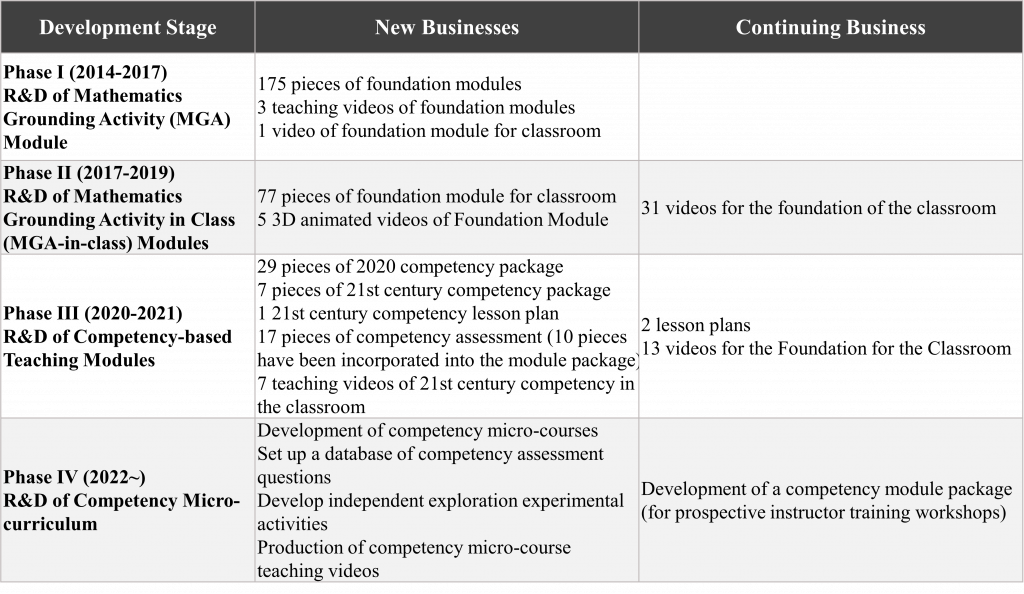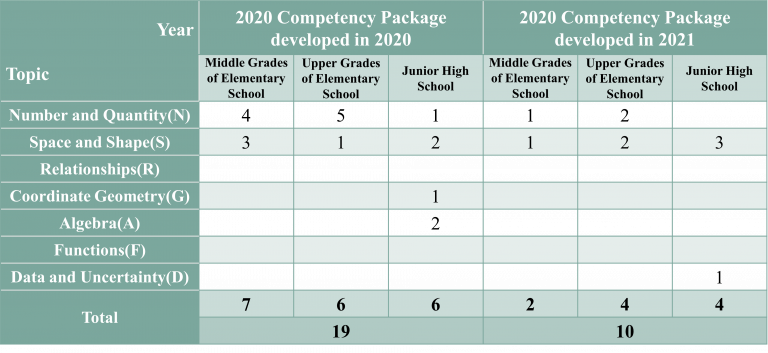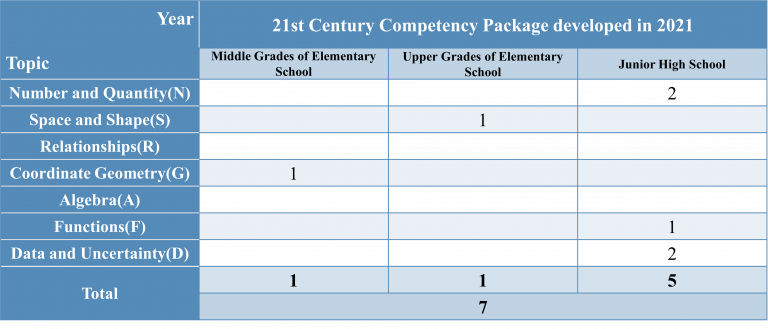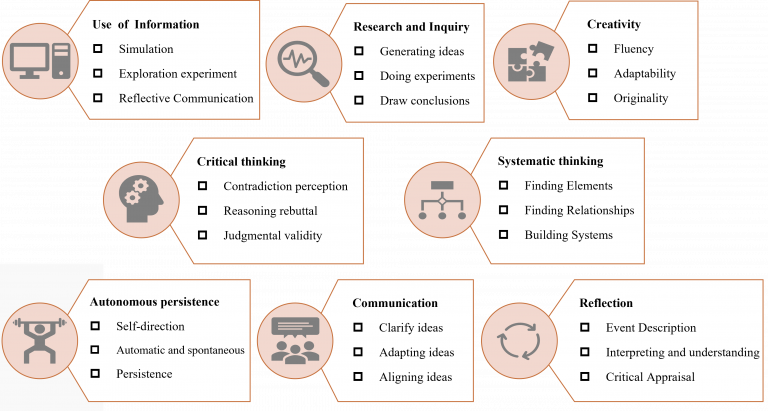Module Curriculum Development

Overview
The main purpose of this program is to develop the Foundations module, hoping that students will be motivated to learn mathematics through lively and interesting mathematical activities that will stimulate their interest in mathematics; develop a tangible experience of learning mathematical content during mathematical activities; let students experience the key points connected with mathematical units; motivate them to explore further related problems driven by curiosity induced by the key points; and then enter the mathematics classroom. Students will then be able to learn the relevant units in the mathematics classroom in a tangible way.
The results of this program are divided into the “Mathematics Foundations Module,” “Mathematics Foundations in the Classroom Module,” “2020 Literacy Foundations Module Package,” and “21st Century Literacy Module Package,” and are divided into seven thematic categories based on the 12-year National Basic Education Curriculum: Number and Quantity (N), Space and Shape (S), Relationships (R), Coordinate Geometry (G), Algebra (A), Functions (F), and Data and Uncertainty (D). Data and Uncertainty (D), and categorize each module in detail. Among them, number and quantity, space and shape, and relationships are the key learning points at the elementary school level, while the middle school starts to switch to the development of scalar geometry, algebra, functions, and data and uncertainty.
The following are the results of each module in each year.
1. Development of Math Foundations Module
From 2014 to 2017, the program developed 175 mathematics foundational modules for middle and upper grade of elementary school, and junior high school students in grades 1 and 2 as listed below.

2. Development of Math Foundation in the Classroom Module
In 2017, we first experimented with the development of three mathematics foundation modules in the Good Fun Math Camp for middle and upper grade of elementary school as well as junior high school students. From 2018 onward, we are committed to transforming the 90-minute foundation modules into “mathematics foundation modules” that can be used in general classrooms, hoping to benefit more students. From 2017 to 2019, a total of 77 modules were developed.

3. R & D 2020 Mathematics Foundations of Literacy Package
Under the promotion of the new 2019 syllabus, this program develops the “Mathematics Foundations of Literacy Package” to meet the spirit of the syllabus. The “Mathematics Foundations of Literacy Package” will be based on the original Foundations to Classroom module. Through the interaction between teachers and students in the Foundations to Classroom module video, we will explore how to design the teaching and assessment of mathematics single element literacy. The design of the module pack will focus on the multiple approaches to the teaching difficulties of the module, the design of “multiple questions, multiple hypotheses” and “multiple solutions, multiple answers” for the literacy assessment, and the contextualized formative assessment for teachers to flexibly adjust and apply, in the hope that teachers can learn teaching strategies that can more effectively promote students’ literacy development.
The mathematics module refers to a chapter of about one week’s teaching content, such as prime numbers, factor multiples, similarity shapes, and Bishop’s Theorem. The instructional materials are the foundational classroom modules, and the assessment refers to the formative assessment in the classroom.
The content plan for each unit of the “Mathematics Foundations of Literacy Package” includes:
- The module contains the content items for the Mathematics area of the 12-year National Basic Education Curriculum (refer to the original lesson plan)
- The “Mathematics Foundations for the Classroom Module” and videos for the module
- The formative assessment tool for the unit on mathematical literacy
- Lesson plan for the module
The goal of the “Mathematics Foundations of Literacy Package” is to develop more sophisticated and effective strategies to promote students’ literacy development by using four interventions: “stimulating thinking”, “diagnostic learning”, “emotional sharing”, and “language evolution”.

4. Development of 21st Century Mathematics Foundations of Literacy Module Pack
In 2021, six 21st Century Mathematics Foundations of Literacy Package are expected to be developed, each focusing on a particular mathematical theme, including two activities on the integration of computers into mathematics learning and one activity on the integration of computer technology into mathematics learning. The mathematical themes may be derived from the refinement of the 2020 Literacy Pack, which was partially redeveloped to enhance the 21st century mathematics-related skills. In order to be closer to the teaching habits of middle school mathematics teachers, this project is expected to develop more diverse lesson plans beyond the foundation modules by following the four principles of mathematics foundational activities: “giving students interest, feeling, ideas, and opportunities to express themselves.

5. Development of mathematical literacy assessment
The challenge for JDM is to interpret each of the 21st century thinking skills in order to inherit the principles of mathematics teaching and learning as advocated and implemented in the Foundations Module, Foundations in the Classroom, and the 2020 Literacy Module Pack, and to quantify the performance of student literacy performance in concrete terms. In 2021, the task of interpreting each skill will be initiated, and each skill will be drafted by a mathematics education scholar, and after discussion and consolidation, the design of a lesson plan, experimental teaching, and the filming of an instructional video on literacy as an indicator of 21st century thinking skills will follow. One of the innovative tasks was the design of the formative assessment of literacy in the classroom and the design of the literacy assessment after the class. The literacy assessment design was initiated with the development of the 21st Century Literacy Module Pack, and will be promoted back to the assessment design of the 2020 Literacy Module Pack.
The literacy assessment to be developed in 2021 will be based on the eight thinking skills listed in the PISA 2022 mathematical literacy assessment, and the three elements of the assessment will be used to design the literacy assessment questions based on the module content to enhance students’ literacy in these skills.


6. Production of JDM Teaching Videos
The JDM program has produced 55 mathematics videos and 5 3D animated videos of mathematics foundational modules from 2016 to 2021. There are three types of instructional videos, including the Foundations Module, Foundations in the Classroom, and 21st Century Math Literacy in the Classroom. The production of the teaching videos can transcend time and location restrictions, allowing teachers from all over the world to watch the videos via the Internet, greatly increasing the convenience of reading and listening, and promoting module teaching.
- The Foundation Module teaching video aims to make the module more complicated to operate, and, through actual operation and photography editing, to produce a more vivid and easy-to-understand video to help other teachers and parents, so that the activities can be implemented more smoothly.
- These videos include how to transform the modules into classroom content and how students play with the modules, and are about 10-15 minutes long and contain several teaching activities.
- The 21st Century Mathematics Literacy in the Classroom video is designed to respond to the 2019 Mathematics Literacy syllabus. It follows the principles of the original Foundations in the Classroom lesson plan and takes into account the teaching inspirations emphasized in the 2019 Mathematics syllabus.
- The 3D animated videos of the Mathematics Foundations module are designed to get students interested in animation through characterization, interesting plot packaging, and colorful graphics, and then to understand and learn. 5 3D animated videos were produced in 2018.
